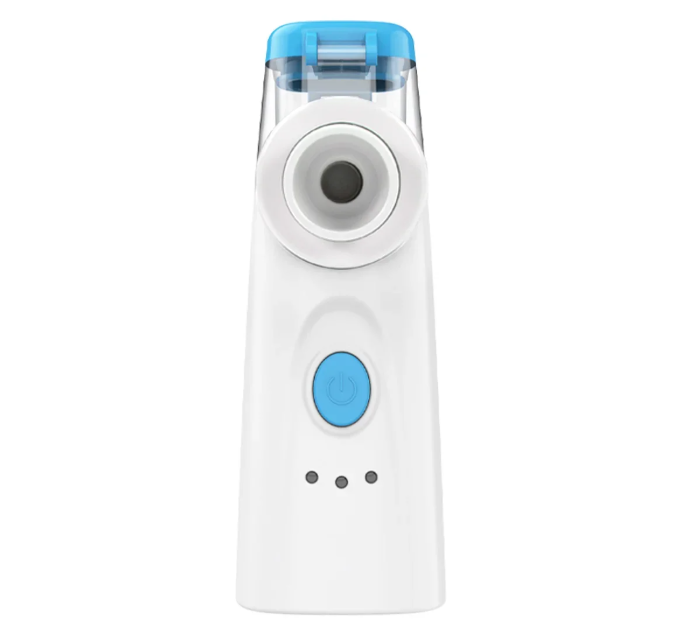Chuanghe Medical’s NBM-7B mesh nebulizer offers a high-performance solution for asthma management. When compared with traditional jet and ultrasonic devices, several critical performance factors differentiate its efficiency, particle delivery, and usability.
1. Nebulization Rate and Particle Size Precision
The NBM-7B operates with a nebulization rate of >0.2 ml/min and generates particles between 0.5–5 μm, with an MMAD of 2.35 μm ±25%. These specifications ensure precise deposition in both upper and lower airways, optimizing therapeutic effectiveness.
-
Mesh vs Jet: Jet nebulizers typically have slower rates (0.15–0.25 ml/min) and larger, less uniform particles (2–6 μm), which reduces deep lung delivery and prolongs treatment time.
-
Mesh vs Ultrasonic: Ultrasonic devices produce fine particles rapidly but may affect heat-sensitive medications due to oscillation-induced warming, while mesh devices maintain particle consistency without heating.
The controlled particle size of mesh nebulizers like NBM-7B maximizes medication utilization and reduces residual waste.
2. Treament Efficiency and Duration
-
NBM-7B: Continuous operation exceeds 1.5 hours per full charge, supporting multiple sessions. Its high efficiency reduces treatment duration compared to jet nebulizers.
-
Jet Nebulizers: Slower aerosolization requires longer sessions and increased patient compliance effort.
-
Ultrasonic Devices: Faster than jets but sensitive to medication viscosity; heat can affect drug stability.
Mesh technology balances speed with precise delivery, improving both adherence and clinical outcomes.
3. Portability and User Convenience
NBM-7B is lightweight, rechargeable via a 3.7V lithium battery or 5V/1A DC, and includes standard accessories (mouthpiece, adult and child masks, Type-C cable).
-
Jet devices: Bulky, require external air compressors, and less suitable for travel or home use.
-
Ultrasonic devices: Medium portability, rely on stable power supply, and require careful handling.
-
Mesh devices: Quiet operation, minimal setup, and easy handling make them ideal for home, office, and travel scenarios.
4. Medication Compatibility and Residual Volume
-
NBM-7B: Low residual volume ensures nearly all medicine is aerosolized; particle size control allows safe delivery of diverse asthma medications.
-
Jet nebulizers: Higher residual volume reduces drug efficiency.
-
Ultrasonic devices: May degrade heat-sensitive medications; residual volume moderate.
Mesh nebulizers ensure precise dose delivery, critical for acute asthma management.
5. Maintenance and Hygiene
NBM-7B incorporates a cleaning mode, simplifying hygiene and reducing contamination risk.
-
Jet nebulizers: Require disassembly and manual cleaning; tubing can harbor pathogens.
-
Ultrasonic devices: Need careful cleaning to avoid water-induced vibration damage.
-
Mesh nebulizers: Minimal maintenance effort, fewer components, and integrated cleaning support prolonged reliable performance.
6. Noise Levels and Patient Comfort
Noise levels influence patient experience:
-
NBM-7B: Operates quietly, reducing stress for children and elderly users.
-
Jet nebulizers: High airflow generates noticeable noise, potentially causing discomfort during therapy.
-
Ultrasonic devices: Generally quieter than jets but may produce subtle mechanical hums.
Quiet operation enhances compliance and reduces inhalation anxiety.
7. Comparative Performance Table
| Feature | Mesh Nebulizer NBM-7B | Jet Nebulizer | Ultrasonic Nebulizer |
|---|---|---|---|
| Nebulization Rate | >0.2 ml/min | 0.15–0.25 ml/min | 0.3–0.5 ml/min |
| Particle Size | 0.5–5 μm | 2–6 μm | 1–5 μm (heat-sensitive) |
| MMAD | 2.35 μm ±25% | 3–4 μm | 2–3 μm |
| Medicine Capacity | 10 ml | 5–8 ml | 5–10 ml |
| Noise | Very low | High | Low |
| Portability | High | Low | Medium |
| Residual Volume | Low | High | Medium |
| Treatment Time | Moderate | Long | Short |
| Medication Compatibility | Wide | Wide | Sensitive to heat or viscosity |
8. Clinical Implications for Asthma
The precise aerosol delivery of mesh nebulizers like NBM-7B enhances clinical outcomes:
-
Deep Lung Deposition: Optimal particle size reaches distal bronchioles efficiently.
-
Shorter Treatment Sessions: Patients can complete therapy faster with consistent dose delivery.
-
Improved Compliance: Quiet, portable, and easy-to-use devices encourage regular usage.
-
Medication Safety: Heat-sensitive formulations remain stable during aerosolization.
9. Safety Features
-
Battery Protections: Overcharge, over-discharge, and short-circuit safeguards.
-
Cleaning Mode: Reduces microbial contamination.
-
Stable Oscillation: Avoids heating and maintains particle consistency.
-
Standards Compliance: Adheres to ISO and ESH guidelines for safe home and clinical use.
10. FAQ
Q1: Can mesh nebulizers deliver medication faster than jets?
A1: Yes, high-efficiency aerosolization shortens treatment time while maintaining particle uniformity.
Q2: Are ultrasonic nebulizers safe for heat-sensitive drugs?
A2: No, ultrasonic vibrations can slightly heat solutions, potentially affecting sensitive medications.
Q3: How portable is the NBM-7B for travel?
A3: Highly portable with rechargeable battery and compact design; ideal for on-the-go use.
Q4: How does particle size affect lung deposition?
A4: 0.5–5 μm particles penetrate both upper and lower airways effectively, optimizing asthma therapy.
Q5: Does NBM-7B require frequent cleaning?
A5: Integrated cleaning mode simplifies maintenance, preventing buildup and contamination.
Conclusion
Mesh nebulizers, exemplified by Chuanghe Medical’s NBM-7B, surpass traditional jet and ultrasonic devices in aerosol efficiency, particle precision, medication utilization, portability, and quiet operation. These features make them the optimal choice for asthma management, ensuring effective, safe, and convenient therapy.
www.chuangheglobal.com
Hainan Chuanghe Medical Technology Co., Ltd.

